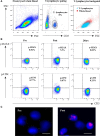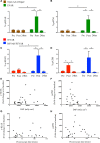Radiation-Induced DNA Damage in Operators Performing Endovascular Aortic Repair
- PMID: 29054934
- PMCID: PMC5753831
- DOI: 10.1161/CIRCULATIONAHA.117.029550
Radiation-Induced DNA Damage in Operators Performing Endovascular Aortic Repair
Abstract
Background: Radiation exposure during fluoroscopically guided interventions such as endovascular aortic repair (EVAR) is a growing concern for operators. This study aimed to measure DNA damage/repair markers in operators perfoming EVAR.
Methods: Expression of the DNA damage/repair marker, γ-H2AX and DNA damage response marker, phosphorylated ataxia telangiectasia mutated (pATM), were quantified in circulating lymphocytes in operators during the peri-operative period of endovascular (infrarenal, branched, and fenestrated) and open aortic repair using flow cytometry. These markers were separately measured in the same operators but this time wearing leg lead shielding in addition to upper body protection and compared with those operating with unprotected legs. Susceptibility to radiation damage was determined by irradiating operators' blood in vitro.
Results: γ-H2AX and pATM levels increased significantly in operators immediately after branched endovascular aortic repair/fenestrated endovascular aortic repair (P<0.0003 for both). Only pATM levels increased after infrarenal endovascular aortic repair (P<0.04). Expression of both markers fell to baseline in operators after 24 hours (P<0.003 for both). There was no change in γ-H2AX or pATM expression after open repair. Leg protection abrogated γ-H2AX and pATM response after branched endovascular aortic repair/fenestrated endovascular aortic repair. The expression of γ-H2AX varied significantly when operators' blood was exposed to the same radiation dose in vitro (P<0.0001).
Conclusions: This is the first study to detect an acute DNA damage response in operators performing fluoroscopically guided aortic procedures and highlights the protective effect of leg shielding. Defining the relationship between this response and cancer risk may better inform safe levels of chronic low-dose radiation exposure.
Keywords: DNA damage; aortic aneurysm; endovascular; occupational exposure; radiation.
© 2017 The Authors.
Figures




Comment in
-
Health Risks of Ionizing Radiation: Dr Roentgen Today.Circulation. 2017 Dec 19;136(25):2417-2419. doi: 10.1161/CIRCULATIONAHA.117.031673. Circulation. 2017. PMID: 29255122 No abstract available.
-
Letter by Doss Regarding Article, "Radiation-Induced DNA Damage in Operators Performing Endovascular Aortic Repair".Circulation. 2018 Jun 12;137(24):2678-2679. doi: 10.1161/CIRCULATIONAHA.118.033691. Circulation. 2018. PMID: 29891633 No abstract available.
-
Response by Patel et al to Letter Regarding Article, "Radiation Induced DNA Damage in Operators Performing Endovascular Aortic Repair".Circulation. 2018 Jun 12;137(24):2680-2681. doi: 10.1161/CIRCULATIONAHA.118.034639. Circulation. 2018. PMID: 29891634 No abstract available.
-
Impact of Ancillary Shielding Barriers on Ionising Radiation Exposure of Vascular Surgeons During Complex Endovascular Aortic Procedures.Eur J Vasc Endovasc Surg. 2022 Jul;64(1):132-133. doi: 10.1016/j.ejvs.2022.04.038. Epub 2022 May 7. Eur J Vasc Endovasc Surg. 2022. PMID: 35537635 No abstract available.
References
-
- Prinssen M, Verhoeven EL, Buth J, Cuypers PW, van Sambeek MR, Balm R, Buskens E, Grobbee DE, Blankensteijn JD Dutch Randomized Endovascular Aneurysm Management (DREAM)Trial Group. A randomized trial comparing conventional and endovascular repair of abdominal aortic aneurysms. N Engl J Med. 2004;351:1607–1618. doi: 10.1056/NEJMoa042002. - PubMed
-
- Greenhalgh RM, Brown LC, Kwong GP, Powell JT, Thompson SG EVAR Trial Participants. Comparison of endovascular aneurysm repair with open repair in patients with abdominal aortic aneurysm (EVAR trial 1), 30-day operative mortality results: randomised controlled trial. Lancet. 2004;364:843–848. doi: 10.1016/S0140-6736(04)16979-1. - PubMed
-
- Weerakkody RA, Walsh SR, Cousins C, Goldstone KE, Tang TY, Gaunt ME. Radiation exposure during endovascular aneurysm repair. Br J Surg. 2008;95:699–702. doi: 10.1002/bjs.6229. - PubMed
-
- Maurel B, Sobocinski J, Perini P, Guillou M, Midulla M, Azzaoui R, Haulon S. Evaluation of radiation during EVAR performed on a mobile C-arm. Eur J Vasc Endovasc Surg. 2012;43:16–21. doi: 10.1016/j.ejvs.2011.09.017. - PubMed
-
- Howells P, Eaton R, Patel AS, Taylor P, Modarai B. Risk of radiation exposure during endovascular aortic repair. Eur J Vasc Endovasc Surg. 2012;43:393–397. doi: 10.1016/j.ejvs.2011.12.031. - PubMed
MeSH terms
Substances
Grants and funding
LinkOut - more resources
Full Text Sources
Other Literature Sources
Medical
Research Materials

